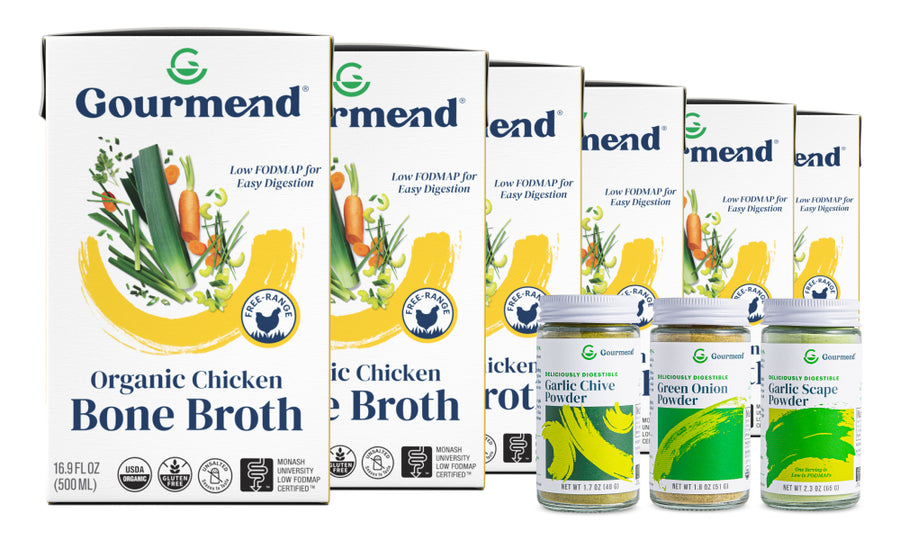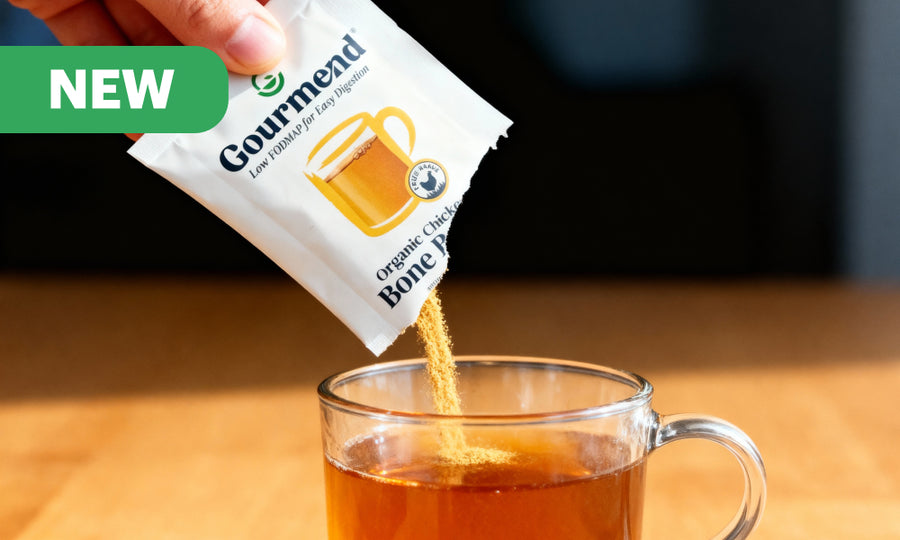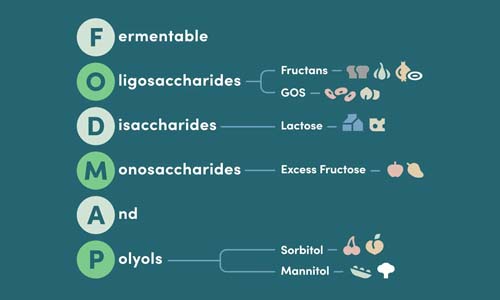Is Oatmeal Low FODMAP? The Complete Guide for IBS

If you're managing IBS or following a low FODMAP diet, you've probably wondered whether your morning bowl of oatmeal is working for or against your digestive comfort. The good news? Oatmeal absolutely can be part of your gut-friendly routine—but portion size is everything. For a deeper dive into FODMAPs and digestive health, see our FODMAP blog.
Key Takeaways
- Oatmeal can be low FODMAP if consumed in specific portion sizes.
- Rolled oats are low FODMAP up to ½ cup uncooked (43g).
- Quick oats should be limited to ¼ cup uncooked to remain low FODMAP.
- Sticking to tested serving sizes is essential for maintaining a low FODMAP diet.
- Oatmeal can be included in a gut-friendly routine for those managing IBS.
Table of Contents
With two-thirds of Americans experiencing digestive issues and nearly 1 billion people worldwide living with IBS, understanding which foods support digestive wellness has never been more important. FODMAPs—fermentable carbohydrates that can trigger bloating, gas, and other uncomfortable symptoms—are found in varying amounts across different foods, including oats. For more on the science behind FODMAPs, check out this Johns Hopkins Medicine overview.
The reality is that oats contain moderate levels of certain FODMAPs, but they're still considered low FODMAP when you stick to research-backed serving sizes. This means you don't have to give up your favorite breakfast—you just need to know how much works best for your gut.
Understanding Oats: Types and Processing
What Are Oats?
Oats are whole grains packed with soluble fiber, particularly beta-glucan, which supports heart health and digestive wellness. Unlike many processed breakfast options, oats provide sustained energy and essential nutrients like magnesium, iron, and B vitamins—all while being naturally gentle on most digestive systems when consumed appropriately.
The fiber in oats acts as a prebiotic, feeding beneficial gut bacteria without the harsh fermentation that high FODMAP foods can cause. This makes oats particularly valuable for anyone looking to support their gut health while managing IBS symptoms. For more on the nutritional benefits of oats and their FODMAP status, see this external resource on oats and FODMAPs.
Types of Oats
Steel-Cut Oats
Steel-cut oats are whole oat groats that have been chopped into small pieces with steel blades. They have a chewy texture and nutty flavor, requiring 20-30 minutes of cooking time. From a FODMAP perspective, steel-cut oats are low FODMAP up to ½ cup uncooked.
Key Point: Steel-cut oats take longer to cook but offer the most robust texture and longest-lasting satiety.
Rolled (Old-Fashioned) Oats
Rolled oats are created by steaming oat groats and then rolling them into flat flakes. This process makes them cook faster than steel-cut oats—usually in 5-10 minutes—while maintaining good texture and nutritional value. These are low FODMAP up to ½ cup uncooked (43g).
Instant/Quick Oats
Quick oats undergo additional processing—they're pre-cooked, dried, and rolled thinner than old-fashioned oats. While convenient for busy mornings, they have a softer texture and are low FODMAP only up to ¼ cup uncooked due to their more concentrated nature.
Consider This: The more processed the oat, the smaller the low FODMAP serving size becomes.
Oatmeal and Oat Bran
Fine oatmeal refers to oats ground into smaller particles, while oat bran is the outer layer of the oat grain, concentrated in fiber. Fine oatmeal can be consumed up to 52g (½ cup), while oat bran is low FODMAP up to 22g (2 tablespoons).
Oats and the Low FODMAP Diet

FODMAP Content in Different Types of Oats
The FODMAP content in oats varies based on processing method, serving size, and any added ingredients. Research from Monash University—the leading authority on FODMAP testing—shows that oats contain moderate levels of fructans and galacto-oligosaccharides (GOS), but remain low FODMAP within specific portion limits.
| Oat Type | Low FODMAP Serving (Uncooked) | Cooking Time |
|---|---|---|
| Steel-cut oats | ½ cup (43g) | 20-30 minutes |
| Rolled oats | ½ cup (43g) | 5-10 minutes |
| Quick oats | ¼ cup | 1-2 minutes |
| Fine oatmeal | ½ cup (52g) | 3-5 minutes |
| Oat bran | 2 tablespoons (22g) | 5-10 minutes |
Portion Size Matters
Here's where many people run into trouble: exceeding these tested serving sizes can quickly push your FODMAP intake into the moderate or high range, potentially triggering symptoms like bloating, gas, or digestive discomfort.
Important: A "serving" refers to the dry, uncooked measurement. Once cooked with liquid, your portion will be much larger—typically 2-3 times the original volume.
Individual tolerance can vary, and some people may find they can handle slightly larger portions during the reintroduction phase of the low FODMAP diet. However, starting with these research-backed amounts gives you the best foundation for digestive comfort.
Expert Tip: We recommend measuring your oats dry before cooking, especially when you're first starting the low FODMAP diet. This ensures you're staying within the tested limits that support digestive wellness.
Oat Milk and Other Oat-Based Products
Oat milk has become incredibly popular, but its FODMAP status is more complex than plain oats. Most commercial oat milk is low FODMAP up to about ½ cup (140g), but this can vary significantly by brand and processing method.
Watch Out For: Many oat milk brands add high FODMAP ingredients like inulin, chicory root, or dates. Always check ingredient lists carefully.
Other oat-based products follow similar portion guidelines:
- Oat biscuits/oatcakes: Usually 2-3 pieces depending on size
- Oat bread: 1-2 slices if oats are the primary grain
- Granola with oats: Check total oat content per serving
The key is understanding that processed oat products often concentrate the FODMAP content, so smaller portions are typically needed compared to plain oats. For more low FODMAP breakfast ideas, visit our Low FODMAP Recipes blog.
Oats, Gluten, and Dietary Restrictions
Oats and Gluten
Here's where things get interesting: oats are naturally gluten-free, but they're often contaminated with wheat, barley, or rye during growing, harvesting, or processing. This contamination is why you'll see some oats labeled as "gluten-free" and others not. For more on this topic, see Monash University's article on oats and gluten.
Regional Differences: In Australia and New Zealand, regular oats are generally considered safe for most people with celiac disease. In the US and Europe, certified gluten-free oats are typically recommended.
Beyond contamination, oats contain a protein called avenin, which is similar to gluten. About 1 in 5 people with celiac disease may react to even pure oats due to this protein. However, this is separate from FODMAP sensitivity—most people following a low FODMAP diet can enjoy regular oats without issues.
Practical Advice for Low FODMAP and Gluten
If you're managing both FODMAP sensitivity and gluten issues, here's our straightforward approach:
- Start with your primary concern: If FODMAPs are your main trigger, regular oats in proper portions work fine
- Add gluten-free if needed: Only choose certified gluten-free oats if you have diagnosed celiac disease or confirmed gluten sensitivity
- Test your tolerance: During FODMAP reintroduction, you can test both regular and gluten-free oats to see if you notice any difference
Our Experience: Most of our customers following a low FODMAP diet don't need gluten-free oats unless they're also managing celiac disease. The FODMAP content matters more for digestive comfort than gluten contamination for most people.
Health and Nutritional Benefits of Oats

Fiber and Digestive Health
Oats are particularly rich in beta-glucan, a type of soluble fiber that forms a gel-like substance in your digestive tract. This unique fiber offers several benefits for gut health:
- Slower digestion: Beta-glucan slows gastric emptying, helping you feel satisfied longer
- Prebiotic effects: Feeds beneficial gut bacteria without the harsh fermentation of high FODMAP foods
- Gentle bulk: Adds substance to stool without causing irritation
- Blood sugar stability: Helps prevent the spikes and crashes that can affect digestion
Why This Matters: Unlike high FODMAP foods that can cause rapid fermentation and gas, the fiber in oats (within low FODMAP portions) supports digestive health without triggering IBS symptoms.
Other Nutritional Highlights
Beyond fiber, oats pack impressive nutritional value into those low FODMAP serving sizes:
| Nutrient | Amount per ½ cup dry oats | Benefit |
|---|---|---|
| Protein | 5-6 grams | Muscle support and satiety |
| Magnesium | 15% daily value | Muscle and nerve function |
| Iron | 10% daily value | Energy and oxygen transport |
| B Vitamins | Various amounts | Energy metabolism |
This nutritional density means you're getting substantial benefits even from the smaller portions required for low FODMAP eating. For more tips on healthy eating with FODMAPs, visit our Learn blog.
How to Prepare Low FODMAP Oatmeal
Key Tips for Keeping Oatmeal Low FODMAP
The beauty of oatmeal lies in its versatility, but staying within low FODMAP guidelines requires some mindful choices. Here's how we approach it:
At a Glance - Low FODMAP Oatmeal Success:
- Measure oats dry before cooking
- Use water or low FODMAP milk alternatives
- Choose toppings carefully
- Avoid pre-flavored varieties with hidden FODMAPs
Liquid Choices: Cook your oats with water for the safest option, or try these low FODMAP milk alternatives:
- Lactose-free dairy milk
- Almond milk (check for no added high FODMAP ingredients)
- Rice milk
- Hemp milk
- Macadamia milk
7 Delicious Low FODMAP Oatmeal Toppings
The right toppings can transform your bowl from bland to brilliant while keeping your gut happy:
- Fresh blueberries - ¾ cup provides antioxidants and natural sweetness
- Sliced strawberries - Up to 1 cup adds vitamin C and bright flavor
- Unripe banana slices - Small portions (about ⅓ medium banana) for potassium
- Natural peanut butter - 2 tablespoons for protein and healthy fats
- Pure maple syrup - 1-2 tablespoons for natural sweetness
- Chia seeds - 1 tablespoon for omega-3s and extra fiber
- Chopped walnuts - ¼ cup for crunch and heart-healthy fats
Quick Answer: The best low FODMAP oatmeal toppings are fresh berries, a small amount of unripe banana, nuts, seeds, and pure maple syrup - all within tested portion sizes.
Step-by-Step: Making Low FODMAP Overnight Oats
Overnight oats are perfect for busy mornings and actually improve digestibility by pre-softening the fiber:
- Combine base ingredients: ½ cup rolled oats, ½ cup lactose-free milk or almond milk
- Add flavor: 1 tablespoon chia seeds, 1 tablespoon maple syrup, pinch of cinnamon
- Mix thoroughly: Stir everything together in a jar or container
- Refrigerate overnight: Let sit for at least 4 hours or overnight
- Top and enjoy: Add fresh berries or other low FODMAP toppings before eating
The beauty of this method is that the oats absorb the liquid slowly, creating a creamy texture without any cooking required. Plus, you can prepare several jars at once for the week ahead.
5 Delicious Low FODMAP Oat Recipes

Ready to put your low FODMAP oat knowledge into practice? These recipes prove that eating for gut health doesn't mean sacrificing flavor or satisfaction.
Overnight Oats with Berries - Effortless Morning Fuel
This make-ahead breakfast delivers creamy texture and antioxidant power without any morning prep work.
- ½ cup rolled oats
- ½ cup lactose-free milk or almond milk
- ¾ cup fresh blueberries
- 1 tablespoon chopped walnuts
- 1 teaspoon maple syrup
Best for: Busy mornings when you need grab-and-go nutrition that won't upset your stomach.
Caramelized Banana Porridge - Comfort Food Reimagined
Transform basic oatmeal into something special with naturally caramelized banana and warming spices.
Pro Tip: Use slightly unripe bananas and keep portions to about ⅓ of a medium banana to stay within low FODMAP limits while maximizing flavor.
- ½ cup rolled oats
- 1 cup water
- ⅓ medium unripe banana, sliced
- ½ teaspoon cinnamon
- 1 tablespoon maple syrup
Best for: Weekend mornings when you want something that feels indulgent but supports digestive wellness.
Peanut Butter & Strawberry Oatmeal - Protein-Packed Power Bowl
This combination delivers sustained energy with the perfect balance of protein, healthy fats, and natural sweetness.
- ¼ cup quick oats (remember the smaller portion for quick oats)
- ¾ cup water
- 2 tablespoons natural peanut butter
- 1 cup sliced strawberries
- 1 tablespoon chia seeds
Ingredient Note: Choose natural peanut butter without added high FODMAP ingredients like honey or inulin.
Best for: Post-workout recovery or when you need lasting energy for a demanding day.
Oat Biscuits (ANZAC-Style) - Gut-Friendly Treats
These crispy, golden biscuits prove that low FODMAP baking can be both delicious and satisfying.
- 1 cup rolled oats
- ½ cup rice flakes
- ¼ cup maple syrup
- ¼ cup coconut oil, melted
- Pinch of salt
Best for: Afternoon snacks or when you're craving something sweet without the digestive consequences.
Strawberry & White Chocolate Baked Oatmeal - Weekend Indulgence
This baked version creates a cake-like texture that feels like dessert but delivers breakfast nutrition.
Make It Special: Use lactose-free white chocolate chips and fresh strawberries for the perfect balance of indulgence and gut-friendliness.
- 2 cups rolled oats
- 1½ cups lactose-free milk
- 2 cups sliced strawberries
- ¼ cup lactose-free white chocolate chips
- 2 tablespoons maple syrup
- 1 teaspoon vanilla extract
Best for: Special occasions or meal prep when you want to bake once and enjoy multiple servings throughout the week.
Tips for Including Oats on a Low FODMAP Diet
Successfully incorporating oats into your low FODMAP routine comes down to consistency and attention to detail. Here's what we've learned works best:
At a Glance - Oat Success Strategies:
- Always measure oats dry before cooking
- Keep a food diary to track your individual responses
- Read labels carefully on processed oat products
- Start with smaller portions if you're new to the low FODMAP diet
Portion Control Mastery
The difference between digestive comfort and discomfort often comes down to just a few extra tablespoons of oats. Measuring portions accurately is crucial for low FODMAP success.
Our Experience: Gourmend customers who measure their oats dry before cooking report much more consistent digestive comfort than those who estimate portions after cooking.
- Invest in a kitchen scale: Weight measurements (like 43g for rolled oats) are more accurate than volume
- Use the same measuring cup: Different cups can vary by 10-15% in actual volume
- Check official updates: FODMAP serving sizes occasionally change as new research emerges
- Consider your total daily intake: Multiple small FODMAP servings can add up
Reading Labels Like a Pro
Processed oat products often hide high FODMAP ingredients that can derail your efforts. Here's what to watch for:
Red Flag Ingredients: Honey, agave, inulin, chicory root, dried fruits, and "natural flavors" can all contain high FODMAPs.
| Product Type | What to Look For | What to Avoid |
|---|---|---|
| Instant oatmeal packets | Plain varieties, minimal ingredients | Fruit flavors, honey, artificial sweeteners |
| Granola with oats | Simple ingredient lists, low sugar | Dried fruits, honey, inulin |
| Oat milk | Oats, water, minimal additives | Gums, locust bean gum, dates |
Building Sustainable Habits
The most successful approach to including oats in your low FODMAP diet is creating systems that don't require constant decision-making. For more inspiration, try our Ultimate Low FODMAP Frittata recipe for a savory breakfast option.
- Meal prep oat portions: Pre-measure weekly servings into containers
- Create go-to combinations: Develop 3-4 favorite oat recipes you can rotate
- Stock low FODMAP staples: Keep approved toppings and mix-ins readily available
- Track your responses: Note how different oat types and timing affect your digestion
Quick Answer: Successfully including oats on a low FODMAP diet requires accurate portion measurement, careful label reading, and consistent tracking of your individual responses.
The Bottom Line on Oats and FODMAPs
So, is oatmeal low FODMAP? Yes, when you stick to tested portion sizes and choose your preparations wisely. Oats offer a perfect example of how the low FODMAP diet isn't about elimination—it's about finding the sweet spot where nutrition, satisfaction, and digestive comfort intersect.
Remember: ½ cup of rolled oats, ¼ cup of quick oats, or ½ cup of steel-cut oats (all measured dry) can be part of your regular routine without triggering FODMAP-related symptoms.
The beauty of oats lies in their versatility and nutritional density. Whether you're managing IBS, seeking cleaner eating options, or simply wanting to start your day with sustained energy, oats deliver fiber, protein, and essential nutrients in a gentle, digestible form.
What matters most is consistency—measure your portions, choose quality ingredients, and pay attention to how your body responds. With these fundamentals in place, oats can become a reliable foundation for satisfying, gut-friendly meals that support your overall wellness goals.
The key to long-term success with any dietary approach is finding foods that nourish both your body and your enjoyment of eating. Oats, prepared thoughtfully within low FODMAP guidelines, offer exactly that balance—proving that eating for digestive health can be both delicious and sustainable.
Check out our Low Fodmap Bundles
Frequently Asked Questions
Can I eat oatmeal on a FODMAP diet?
Yes, oatmeal can be part of a low FODMAP diet when consumed in moderate amounts. Rolled oats are low FODMAP at servings of about 1/2 cup (dry), which provides a good source of fiber without triggering symptoms. Portion control is key because larger servings may introduce higher FODMAP levels that could cause discomfort.
Can oatmeal cause IBS flare up?
Oatmeal can cause IBS flare-ups if eaten in large portions or if it’s combined with high FODMAP toppings like honey or dried fruit. For many people, moderate oatmeal servings are gentle on digestion and provide soluble fiber that supports gut health. Monitoring portion size and pairing oatmeal with low FODMAP ingredients helps prevent symptoms.
What is a low FODMAP breakfast?
A low FODMAP breakfast includes foods that are easy to digest and don’t trigger IBS symptoms. Think oatmeal with safe toppings like fresh berries or a small handful of nuts, scrambled eggs with chives, or a smoothie made with lactose-free yogurt and low FODMAP fruits. These meals offer balance, flavor, and digestive comfort to start your day right.
Which breakfast cereal is low in FODMAP?
Low FODMAP breakfast cereals are typically made from gluten-free oats, rice, or corn without added high FODMAP ingredients like honey or high-fructose corn syrup. Plain rolled oats, puffed rice, and certain gluten-free flakes fit the bill. Always check labels for added fibers or sweeteners that could increase FODMAP content.
Is coffee low in FODMAP?
Yes, coffee itself is low FODMAP and safe for most people with IBS when consumed in moderate amounts. However, coffee can sometimes irritate the gut due to its acidity and caffeine content, so tolerance varies. Choosing low FODMAP milk or milk alternatives and avoiding high FODMAP creamers keeps your coffee gut-friendly.
Is peanut butter low in FODMAP?
Peanut butter is low FODMAP when eaten in moderate portions, typically up to 2 tablespoons per serving. It’s important to choose natural peanut butter without added high FODMAP ingredients like honey or high-fructose corn syrup. Peanut butter offers healthy fats and protein that make it a satisfying, gut-friendly option.





